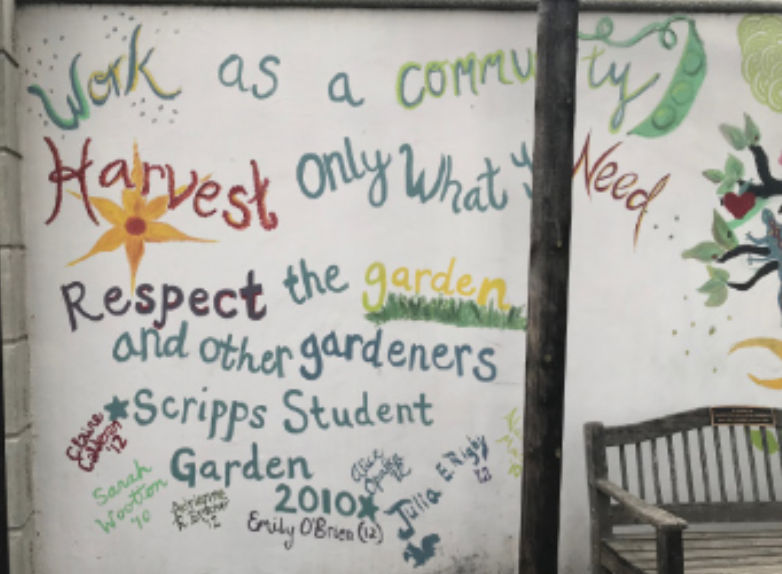By Sondra Abruzzo ’19
Staff Writer
The most common reaction I get after mentioning the Scripps student garden is, “What? We have a garden? Where is it?” Well, my friends, the Scripps student garden serves as a place for students to grow their own fruits and vegetables while hanging out in a fun and sunny communal space. It sits between Browning and the Toll and Browning/Dorsey Parking lots, hidden behind the big Scripps wall on Platt Blvd.
The garden began back in 2002, when a group of students designed the space, built the brick planters we still use today, and planted a variety of fruit trees and vines to decorate the garden. Over the years, the garden club has done lots of programming to get students involved and excited about cultivating their own plants, food, and community space, while also engaging with sustainability efforts on campus.
“Being a part of garden club meant a lot more than planting and harvesting,” said the 2016-2018 Student Garden Coordinator Erika Johnson ’18. “It was also community events such as the sustainability fair, helping with the compost program, helping grounds decide on what fruiting trees to plant, and donating fresh produce to both the dining halls and local groups in the community. Some of my favorite events were community meals that were cooked by students with produce grown in the garden. We also had a fermenting event that was a collaboration with students from Harvey Mudd in which students learned how to make sauerkraut and a brew kombucha in their dorms”
Although the garden serves as an amazing resource for community building and access to fresh food, its hidden nature (both literally and figuratively) prevent it from reaching its full potential.
“Being behind gates and walls on the north side of Browning residence hall, very few students knew about the garden,” Johnson said. “Each year, we would grow lots of free organic food for Scripps students, but this was a frequently underutilized resource. Notably, students that worked on campus over the summer were able to enjoy hundreds of fresh tomatoes, basil, zucchini, peppers, beans, and many other fruits and vegetables. While summers were a great time to harvest, maintenance was difficult as there was not a dedicated group on campus keeping the garden watered and weeded.”
More problems arise for the garden when there is no structured leadership tending to the space. This year, there was no Student Garden Coordinator position as the grounds department was already dealing with the loss of our Sustainability Coordinator Tiffany Ortamond and the Director of Grounds Lola Trafecanty. Nevertheless, Landscape Operations Manager, Joya Salas stepped in and worked with Grounds to perform general upkeep of the garden which included mowing, irrigation repairs, weed removal, and maintenance of the peripheral landscaping. They also planted nine new fruit trees including Mexican lime, guava, Santa Rosa plum, and a kiwi vine.”
Students have also come together on their own volition this year to plant beets, sage, strawberries, among other flowers and vegetables.
In the future, Salas aims to “have a continuous seasonal supply of fresh herbs, vegetables and fruit growing in the student garden. My hope is for the students to take full advantage of the space by planting and tending their favorite crops. The area is perfect for creating community, relaxing with friends and cultivating a farm to table culture on campus.”
Many agree that the garden could and should become a greater part of the Scripps culture. In fact, in the fall of 2017 students met with the Scripps administration to push forward an initiative to redo the garden area. According to Johnson, “These new plans included features such as a raised deck for yoga surrounded by hammocks, expanded vegetable beds, a large picnic table for communal eating, covered areas with flowering and fruiting vines, study spaces outdoors including sliding chalkboards, and a pizza oven.” Plans were drawn up, funding was approved, and all the project needed was an alumni donation to complete the project funding. However, when the school year ended, the seniors who spearheaded the project graduated, and the staff who supported it left, the project came to a halt. Although they have the plans, the administration has had little to no conversation about further pursuing the project.
With greater awareness and participation in the garden, we can again push to improve this space for the community. Ideally, the garden can serve a source of community making, wellness, and of course, fresh produce. Students are already suggesting ways that it can improve, such as focusing on indigenous plants, recognizing that these campuses exist on Tongva land, and painting a mural be painted on the wall behind the garden.
While some may feel like the garden is exclusive, it really is not meant to be that way. All students should feel free to enter the garden, explore, and plant whatever they like. Maintenance, planting, and harvesting parties occur throughout the year, so join the Scripps Garden Club Facebook group for more updates on when to participate. Community gardens take lots of love and labor, so any bit you can give goes a long way.



